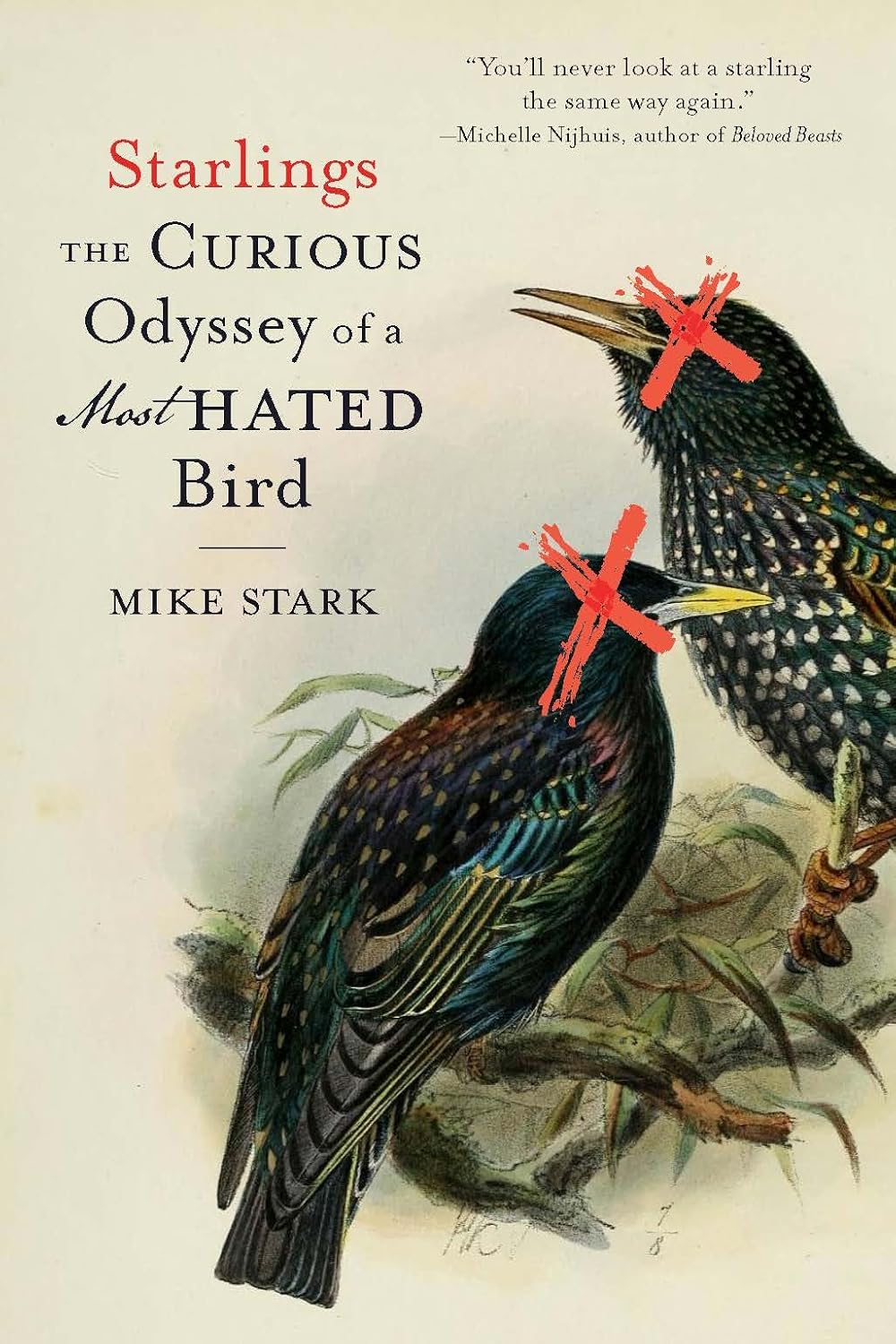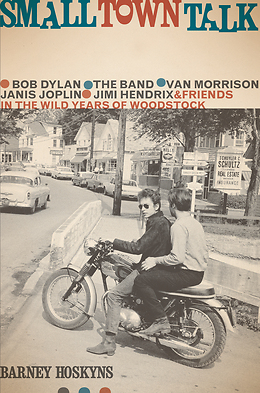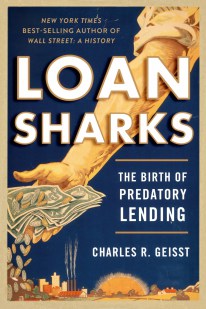Starlings: The Curious Odyssey of a Most Hated Bird
- By Mike Stark
- Bison Books
- 272 pp.
- Reviewed by Julie Dunlap
- April 4, 2025
Have these winged wonders finally earned acceptance?

Few DC residents in 1914 noticed the first scattering of dark, speckled songbirds alighting in winter-bare city trees. But within a decade, chortling and whistling European starling flocks, “dense as a black storm cloud,” were widely reviled. Slippery, acidic droppings put buildings and pedestrians at risk, and frantic campaigns were launched to eradicate the invaders’ roosts by any effective means.
Acetylene flash guns, traps, and toxic gas failed, as did water hoses, balloons, fake owls, and cat-o-nine tails. The Evening Star newspaper asked readers for fresh ideas; suggestions ranged from boiling starling eggs to equipping afflicted buildings with giant windshield-wiper-like devices to whisk the birds away. “Here their nocturnal squeals and chatterings reach the ears of the mighty,” lamented a local ornithologist, “the bird hater and even the bird lover periodically join the chorus of damnation.”
Imported in the 1880s for release in Central Park, the gregarious natives of Eurasia and northern Africa rapidly multiplied to become our continent’s second-most-common wild bird. How could Mike Stark, the intrepid author of Chasing the Ghost Bear: On the Trail of America’s Lost Super Beast, resist writing about another enigmatic creature, a feathered omnivore more myth than substance to most of us? The result is Starlings: The Curious Odyssey of a Most Hated Bird, a lively revelation of starling behavior, evolution, history, and relentless persecution for the crime of being prolific and adaptable.
Stark begins by expanding on starlings’ familiar North American origin story. Yes, all 90 million of the continent’s extant wild starlings descend from 72 glossy immigrants released by Eugene Schieffelin (1827-1906), the greying scion of an entrepreneurial family and “man of leisure,” according to his passport application. As president of the American Acclimatization Society, Schieffelin was a leader in a global movement to introduce “useful or interesting” exotic species (e.g., silkworms, pike hares, partridges, eland, and more) chosen to enhance perceived shortcomings of native fauna and flora.
Passages on the diverse, often pecuniary, and sometimes absurd motivations of movement adherents are among the book’s most amusing and provocative. “These were men,” writes Stark, “who felt certain they could improve on what nature had already provided, dreaming of better birds in the air and sweeter songs in the sky.”
Like most nonnative species, whether deliberately or accidentally introduced, the first few Sturnus vulgaris quietly vanished. But to the society’s delight, persistence paid off. A starling “evangelist” and director of Central Park’s zoo predicted the newcomers would vanquish caterpillars and other garden pests, while gracing park trees with iridescent plumage and merry voices.
Hostility developed almost as swiftly as the birds, which raised two clutches of six eggs per summer, multiplied, and colonized the alien landscape. Drawn to cities for winter shelter, 100,000 merry singers became a shrill (and smelly) din. More than one desperate mayor fell prey to scam artists like the Bird Man — aka Otto Standke — armed with a mysterious box of tools professed to disperse the hordes. Standke could use “alchemy, witchcraft or moral suasion,” said Mount Vernon, New York, officials, as long as the starlings departed. It was the Bird Man who left, though, and town fathers who ordered police to aim shotguns at the trees.
Rural enmity grew even fiercer. Orchard owners raged when flocks devoured ripening cherries, apples, grapes, and blueberries. Farmers railed against an “enemy gathering at the far horizon” that gobbled feed grains and probed under cattle skin with sharp yellow beaks to harvest fly larvae. Like a horror movie, a gathering flock could trigger a tormented herd to stampede.
Amateurish anti-starling skirmishes escalated by the 1920s into government-backed chemical warfare. Stark visits Colorado to investigate decades of USDA experimentation on lethal gases, surfactants, and oral toxins such as DRC 1339, which kills starlings (and pigeons, grackles, crows, and gulls) from blood poisoning days after it’s ingested. Starlicide is a mere fraction of the work of an obscure federal agency, Wildlife Services, tasked with harassing and destroying coyotes, bears, foxes, and other native and non-native species blamed for economic damage or labeled as nuisances. Stark calculates that between 2008 and 2022, Wildlife Services killed over 18 million starlings. “No animal is targeted more often,” he says, “and in such abundance, as the European starling.”
Stark sometimes tempers such gruesome realities with gentler perspectives. Even elimination advocates in the book express grudging admiration for the species’ intelligence, adaptability, and rapid evolution to exploit distinct North American habitats. An early and eloquent voice for starling tolerance was Rachel Carson. In a 1939 essay, she condemned savage attacks on a “cheerful bird” that damages less fruit than robins and fills its stomach with agricultural pests such as cutworms, weevils, and grasshoppers. The future insecticide critic asked:
“Shall we then continue to regard him as an alien or shall we conclude that his successful pioneering and his service in insect destruction entitle him to American citizenship?”
Other writers, filmmakers, birders, and mathematicians rhapsodize over starlings’ most wonderous behavior: murmurations — synchronized evening flights that swell, writhe, undulate, dive, and hold witnesses spellbound. Computer models have cracked the conundrum of how the sky ballet is accomplished, but as Stark insists, “For most people, the starstruck observers among us, they occupy another realm, one dominated less by logic and more by mystery and delight.”
Readers eager to know starlings more personally, to relish individuals’ clever antics and charming mimicry skills, may prefer Lyanda Lynn Haupt’s intimate Mozart’s Starling to Stark’s thorough but arms-length portrait. Some will also wish he delved deeper into societal biases against any species labeled non-native. On a rapidly changing planet, no pristine ecosystems remain; adaptable survivors, whether native or not, may be essential ecological components — the ones most likely to persist. It may be time for more nuance in our assessments of the natural and cultural roles of introduced animals and plants.
The distance Stark maintains with his species-level focus saves room for a shocking plot twist: After peaking around 1970 at about 200 million, starling flocks have declined more than 50 percent in North America and up to 90 percent in parts of their native Europe. Though “hearty travelers, cognitive superheroes, and first-class colonizers,” says Stark, their fate “raises grave questions about what’s in store for the rest of the natural world, not to mention us.”
The odyssey in Starlings encompasses more than a century of avian trials and triumphs. The perils starlings face and the wonders they inspire earn them their role as epic heroes in Stark’s thought-provoking tale. Balanced and reflective, Starlings calls on readers to challenge their prejudices and misconceptions of one noisy three-ounce blackbird, a vital step in our own journey to recast the meaning of belonging on a chaotic and increasingly violent Earth.
Julie Dunlap writes and teaches about wildlife ecology, environmental history, and climate change. Her most recent children’s book is I Begin with Spring: The Life and Seasons of Henry David Thoreau (Tilbury House).

